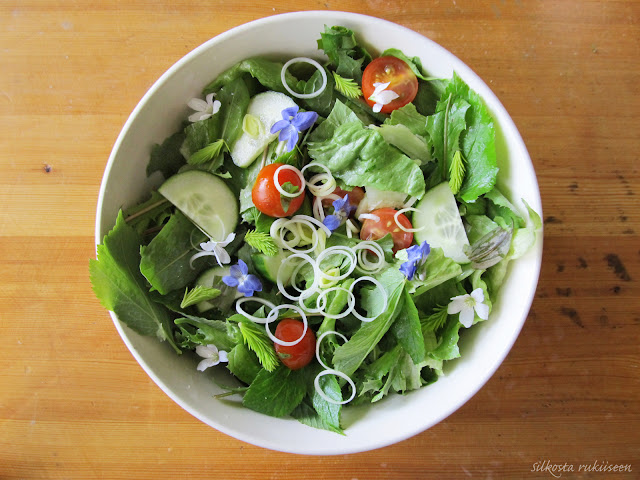"Mehun keitosta jää runsaasti maukasta sosetta, jonka voi käyttää hyödyksi jälkikäteen.
Ei ole montaa
kasvia, joka vetäisi vertoja raparperin raikkaudelle, muunneltavuudelle ja
satoisuudelle. Näin äkkiseltään ajateltuna mieleen ei itse asiassa tule yhtään!
Raparperi taipuu juomiksi, hilloiksi ja kiisseleiksi, maustaa kakut, piirakat
ja muffinssit sekä terästää jäätelöt ja grilliruoat. Se on ensimmäisiä kasveja
jotka putkahtavat maasta keväällä ja jatkaa runsasta kasvuaan pitkälle kesään.
Kirpeä oksaalihappo jakaa raparperin maistelijat selkeästi kahtia: toiset
rakastavat raikasta makua, toiset karsastavat sitä liian voimakkaana. Omasta
mielestäni raparperin happamuus sopii erinomaisesti erilaisiin ruokiin.
Suurimmat suosikkini ovat siitä valmistettavat erilaiset juomat, kuten
raparperisima sekä -mehu.
Raparperimehu:
3 l raparperia
5 dl vettä
n. 7 dl sokeria
Huuhtele tai kuori
raparperit ja paloittele ne. Keitä suuressa kattilassa pienessä määrässä vettä
n. 10 min, kunnes raparperit ovat soseutuneet. Siivilöi mehu siivilän ja
harsokankaan läpi. Älä painele sosetta siivilässä, jotta mehusta tulisi
kirkasta. Mittaa valutettu mehu ja kiehauta se uudelleen. Kuori pintaan
muodostuva vaahto pois ja lisää mehuun n. 3 1/2 – 5 dl sokeria mehulitraa
kohden. Pullota kuuma mehu puhtaisiin ja uunissa kuumennettuihin lasipulloihin.
Raparperin kuoret
tuovat mehuun kaunista väriä, joten voit hyvin jättää varret kuorimatta. Mehun
keitosta jää toisaalta runsaasti maukasta sosetta, jonka voi käyttää hyödyksi
jälkikäteen. Tällöin puisevat kuoret kannattaa poistaa. Soseesta voi keittää
pikahilloketta joka maustaa mukavasti jäätelön tai räiskäleet, toisaalta voit
käyttää sitä yhtä lailla kakkujen tai piirakoiden täytteenä. Muista nauttia maitotuotteita raperperin kanssa.
* *
*
There’s not many plants that can beat rhubarb
in the freshness, versatility and high-yieldingness. To come to think of it,
right now I can’t come up with any! Rhubarb can be turned into drinks, jams and
kissel, it seasons cakes, pies and muffins and spices up ice-creams and grill
food. It is among the first plants to stick out of the ground in the spring and
will keep on growing late in the
summer. The acrid oxalic acid divides people into two: some love the fresh
flavour, some dislike it. I think the sourness fits perfectly into different
types of food. My biggest favourites are the drinks, for instance rhubarb mead
and juice.
Rhubarb Juice:
3 l (6 pt) rhubarb
5 dl (1 pt) water
about 7 dl (1 1/2 pt) sugar
Rinse or peel the rhubarbs and cut them into
pieces. Place the rhubarb into a large kettle with the water and cook for about
10 minutes, until turned into mash. Sieve the juice through a cloth: avoid
pressing the mash so that the juice will be clear. Measure the juice, place it
back into the kettle and bring to a boil. Remove the foam that is formed on the surface and add about 3 1/2 – 5 dl of sugar per
each litre of the juice. Bottle the juice into clean and hot glass bottles.
The skin of rhubarb will bring the juice nice
colour so it’s not necessary to peel the stems. However, the mash that is left
over from the juice can be used later on and the woody skin is not nice then.
You can cook the mash with some sugar and use it in ice-cream and pancakes or
as filling in cakes and pies. Remember to also have some milk products with
rhubarb.













